View in other NatureServe Network Field Guides
NatureServe
Montana
Utah
Wyoming
Idaho
Wisconsin
British Columbia
South Carolina
Yukon
California
New York
Shasta Slant-faced Grasshopper - Bruneria shastana
Other Names:
Stenobothrus shastanus
General Description
The following is from Helfer (1971), Otte (1981), Vickery and Kevan (1985), and Scott (2010). A dark brown to black grasshopper with an ivory to white longitudinal stripe extending from the antennae to the upper mandibles. It lacks the dorsal stripe on the head and pronotum as occurs on its congener, the
Brunner's Grasshopper (
Bruneria brunnea). The hind tibia is whitish at its apex and red from the middle to its terminus.
Phenology
Seasonal occurrence data is meager. Adults occur from mid-July to September.
Diagnostic Characteristics
the following comes from Helfer (1971), Otte (1981), Vickery (1985), and Scott (2010). Male body length is 15 mm to 25 mm, and females are 19 mm to 26 mm. The lateral lobes of the pronotum narrow ventrally. The wings (tegmina) lack spots and are short. Female wings are shorter than the combined length of the head and pronotum and may overlap on the dorsal surface. Male wings are longer than the head and pronotum but never reach the tip of the abdomen. The female has strong dark bands on the side of each abdominal segment.
This species can be confused with its congener the
Brunner's Grasshopper (
Bruneria brunnea), and possibly the
Club-horned Grasshopper (
Aeropedellus clavatus), the
Four-spotted Grasshopper (gray-brown form) (
Phlibostroma quadrimaculatum), and the
Brown-spotted Range Grasshopper (
Psoloessa delicatula). Refer to these species to compare diagnostic characteristics. Note: Some Orthoptera texts, field guides, and literature classify this species as
Stenobothrus shastanus (Capinera and Sechrist 1982, Otte 1981, and Scott 2010).
Species Range
Montana Range
Range Descriptions
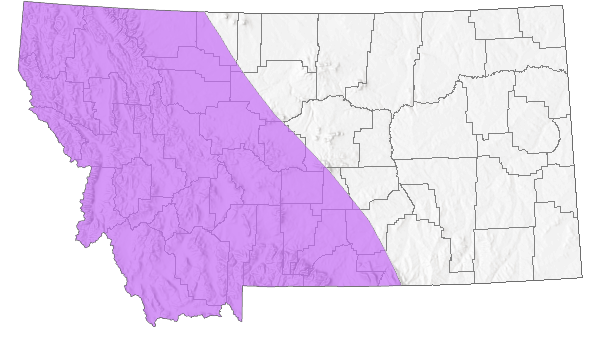
 Native
Native
Range Comments
Limited in geographic distribution from the Pacific Northwest, Idaho and Montana southward to Utah and Nevada, and from eastern California eastward to north-central Wyoming. In Montana, it has been reported in 4 counties(Otte 1984, Pfadt 2002, Scott 2010, and Vickery and Kevan 1985).
Observations in Montana Natural Heritage Program Database
Number of Observations: 3
(Click on the following maps and charts to see full sized version)
Map Help and Descriptions
Relative Density
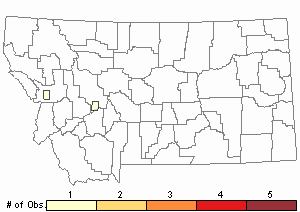
Recency
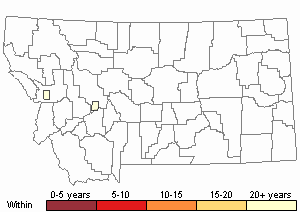

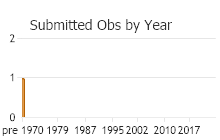
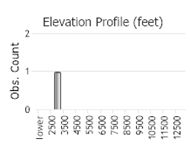 (Observations spanning multiple months or years are excluded from time charts)
(Observations spanning multiple months or years are excluded from time charts)
Habitat
The Shasta Slant-faced Grasshopper inhabits mountain meadows, forest openings, loose rocky soils or talus with bunchgrasses at elevations from 4,000 to 12,000 feet. Varied vegetation types are inhabited, consisting of bluegrasses (Poa), wheatgrass (Agropyron), fescues (Festuca), sacaton and dropseed (Sporobolus). It is generally a mountain-foothills species (Otte 1984, and Vickery and Kevan 1985).
Food Habits
This species is a grass-feeder and field observations indicate that its preferred host plants are the bluegrasses, wheatgrass and fescues.
Reproductive Characteristics
Currently, no studies have been made regarding this species life cycle and reproductive behaviors.
Stewardship Responsibility
References
- Literature Cited AboveLegend:
 View Online Publication
View Online Publication Capinera, J.L. and T.S. Sechrist. 1982. Grasshoppers of Colorado: Identification, Biology, and Management. Fort Collins, CO: Colorado State University Experiment Station, Bulletin 584S. 161 p.
Capinera, J.L. and T.S. Sechrist. 1982. Grasshoppers of Colorado: Identification, Biology, and Management. Fort Collins, CO: Colorado State University Experiment Station, Bulletin 584S. 161 p. Helfer, J.R. 1971. How to Know the Grasshoppers, Crickets, Cockroaches, and Their Allies. Revised edition (out of print), Mineola, NY: Dover Publications.
Helfer, J.R. 1971. How to Know the Grasshoppers, Crickets, Cockroaches, and Their Allies. Revised edition (out of print), Mineola, NY: Dover Publications. Otte, Daniel. 1981. The North American Grasshoppers. Volume 1. Acrididae (Gomphocerinae and Acridinae). Harvard University Press. 275 pp.
Otte, Daniel. 1981. The North American Grasshoppers. Volume 1. Acrididae (Gomphocerinae and Acridinae). Harvard University Press. 275 pp. Scott, R.D. 2010. Montana Grasshoppers, Katydids, and Crickets A Pictorial Field Guide to the Orthoptera. MagpieMTGraphics, Billings, MT.
Scott, R.D. 2010. Montana Grasshoppers, Katydids, and Crickets A Pictorial Field Guide to the Orthoptera. MagpieMTGraphics, Billings, MT. Vickery, V. R. and D. K. M. Kevan. 1985. The grasshopper, crickets, and related insects of Canada and adjacent regions. Biosystematics Research Institute, Ottawa, Ontario. Publication Number 1777. 918 pp.
Vickery, V. R. and D. K. M. Kevan. 1985. The grasshopper, crickets, and related insects of Canada and adjacent regions. Biosystematics Research Institute, Ottawa, Ontario. Publication Number 1777. 918 pp.
- Additional ReferencesLegend:
 View Online Publication
View Online Publication
Do you know of a citation we're missing? Anderson, N.L. 1962. Grasshopper-vegetation relationships on Montana grasslands. Ph.D Dissertation. Bozeman, Montana: Montana State University. 73 p.
Anderson, N.L. 1962. Grasshopper-vegetation relationships on Montana grasslands. Ph.D Dissertation. Bozeman, Montana: Montana State University. 73 p. Capinera, J.L., R.D. Scott, and T.J. Walker. 2004. Field Guide to Grasshoppers, Katydids, and Crickets of the United States. Ithaca, NY. Cornell University Press.
Capinera, J.L., R.D. Scott, and T.J. Walker. 2004. Field Guide to Grasshoppers, Katydids, and Crickets of the United States. Ithaca, NY. Cornell University Press. Hebard, M. 1928. The Orthoptera of Montana. Proceedings of the Academy of Natural Sciences of Philadelphia, Vol. 80:211-306.
Hebard, M. 1928. The Orthoptera of Montana. Proceedings of the Academy of Natural Sciences of Philadelphia, Vol. 80:211-306.
- Web Search Engines for Articles on "Shasta Slant-faced Grasshopper"
- Additional Sources of Information Related to "Insects"





